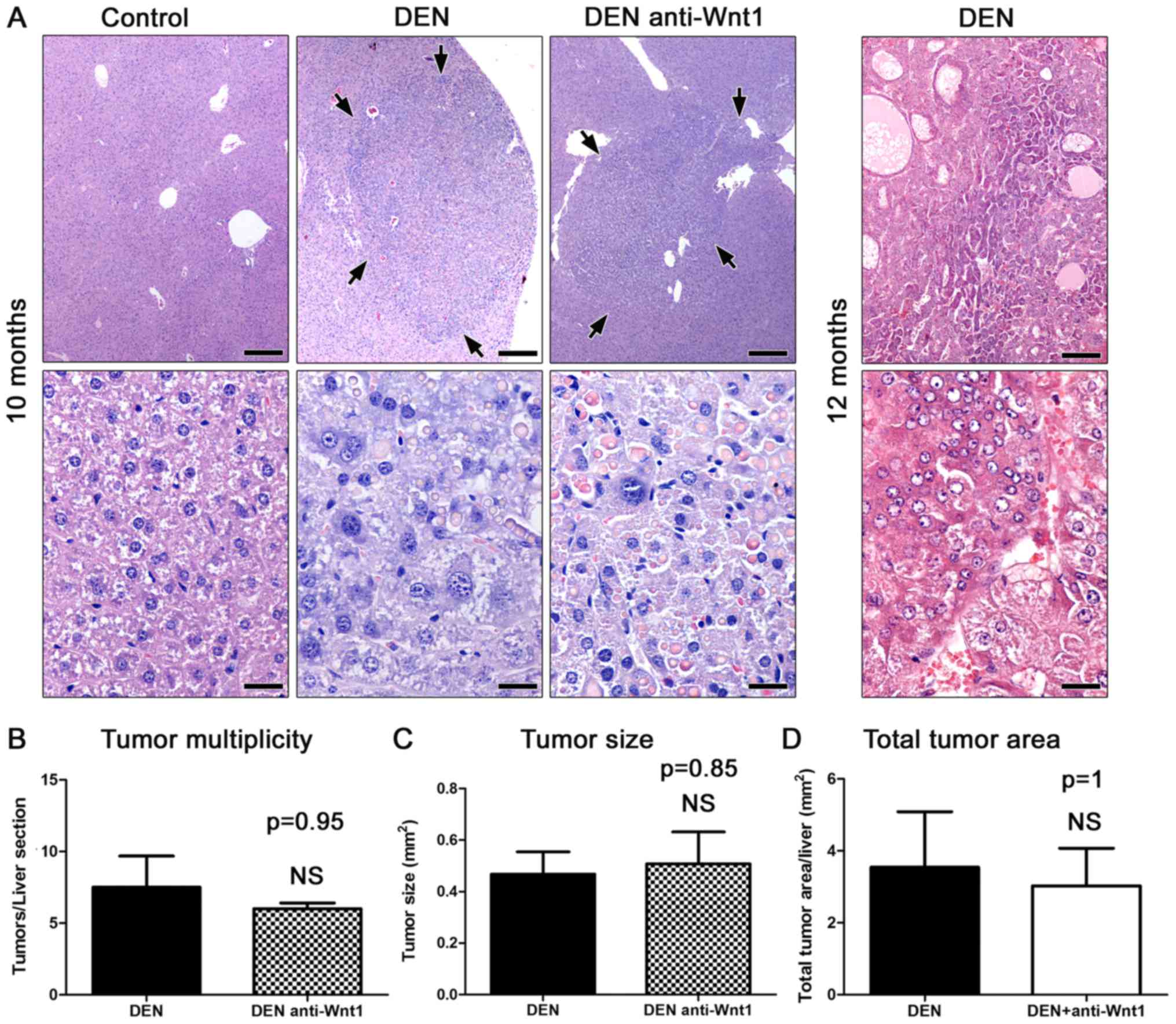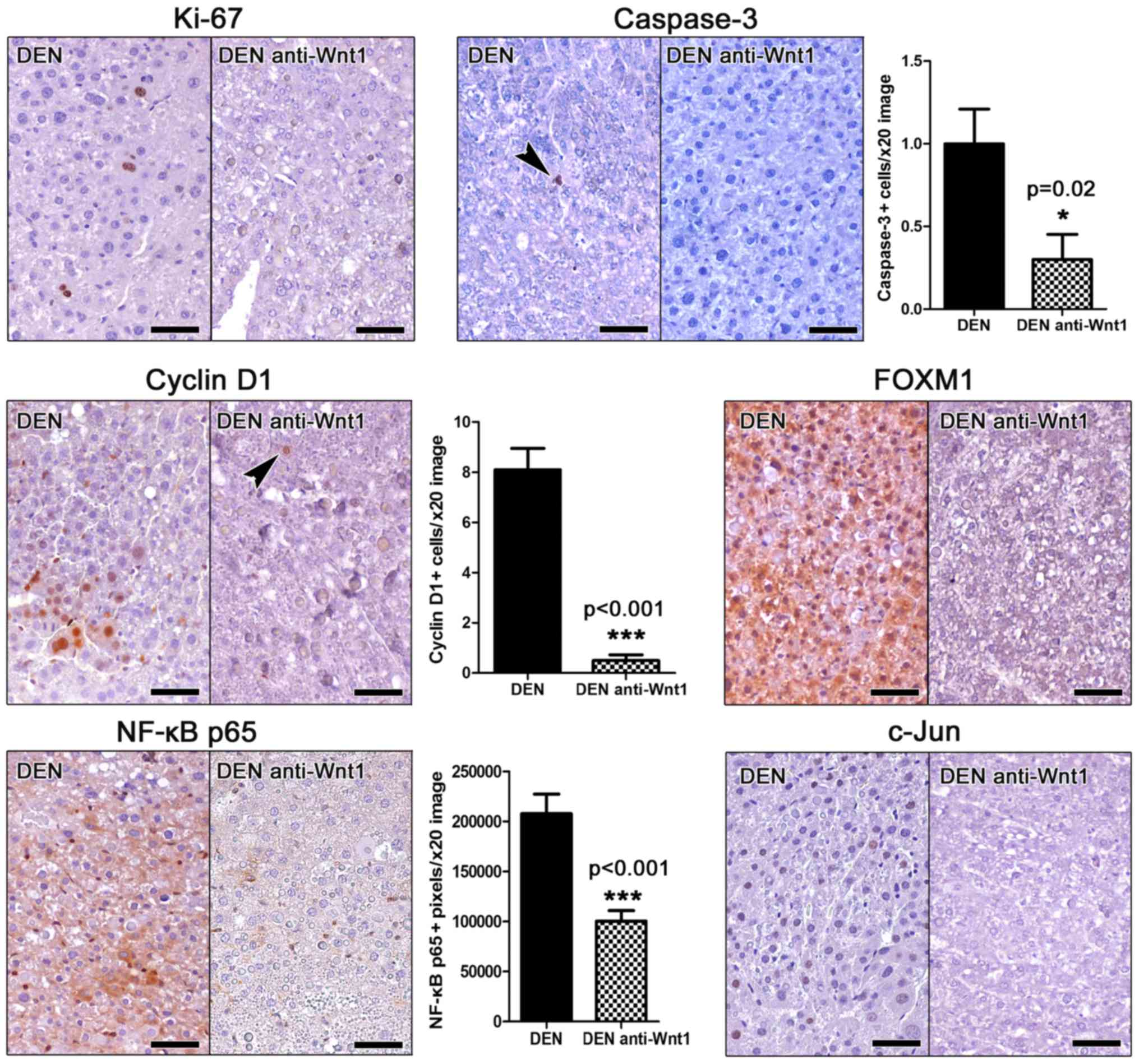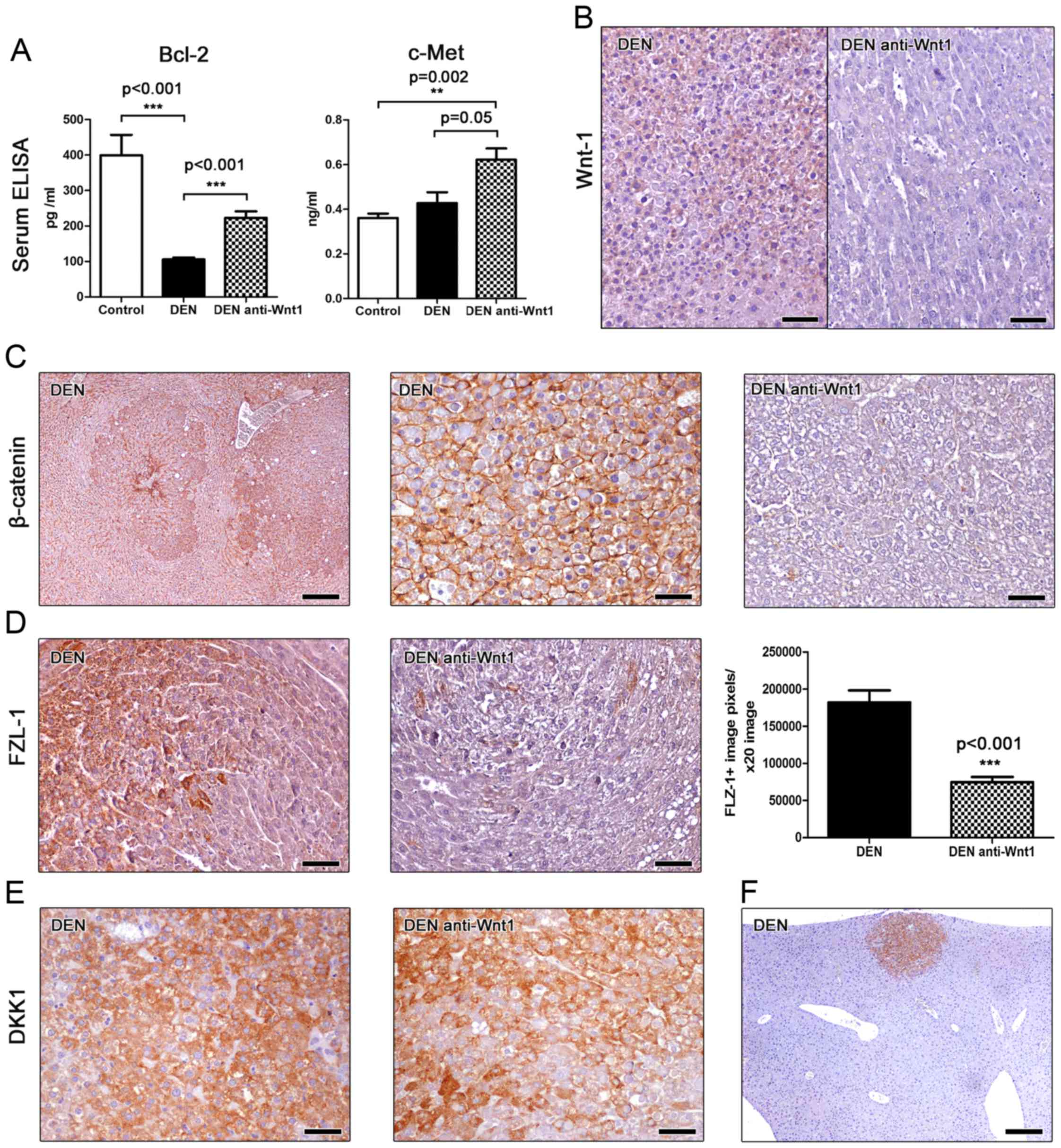|
1
|
Santos NP, Colaço AA and Oliveira PA:
Animal models as a tool in hepatocellular carcinoma research: A
review. Tumor Biol. 39:10104283176959232017. View Article : Google Scholar
|
|
2
|
Heindryckx F, Colle I and Van Vlierberghe
H: Experimental mouse models for hepatocellular carcinoma research.
Int J Exp Pathol. 90:367–386. 2009. View Article : Google Scholar : PubMed/NCBI
|
|
3
|
Giakoustidis A, Giakoustidis D, Mudan S,
Sklavos A and Williams R: Molecular signalling in hepatocellular
carcinoma: Role of and crosstalk among WNT/β-catenin, sonic
hedgehog, notch and dickkopf-1. Can J Gastroenterol Hepatol.
29:209–217. 2015. View Article : Google Scholar : PubMed/NCBI
|
|
4
|
Kim Y, Sills RC and Houle CD: Overview of
the molecular biology of hepatocellular neoplasms and
hepatoblastomas of the mouse liver. Toxicol Pathol. 33:175–180.
2005. View Article : Google Scholar : PubMed/NCBI
|
|
5
|
Lee JS, Chu IS, Mikaelyan A, Calvisi DF,
Heo J, Reddy JK and Thorgeirsson SS: Application of comparative
functional genomics to identify best-fit mouse models to study
human cancer. Nat Genet. 36:1306–1311. 2004. View Article : Google Scholar : PubMed/NCBI
|
|
6
|
Goldfarb S, Pugh TD, Koen H and He YZ:
Preneoplastic and neoplastic progression during
hepatocarcinogenesis in mice injected with diethylnitrosamine in
infancy. Environ Health Perspect. 50:149–161. 1983. View Article : Google Scholar : PubMed/NCBI
|
|
7
|
Bupathi M, Kaseb A, Meric-Bernstam F and
Naing A: Hepatocellular carcinoma: Where there is unmet need. Mol
Oncol. 9:1501–1509. 2015. View Article : Google Scholar : PubMed/NCBI
|
|
8
|
Monga SP: Role of Wnt/β-catenin signaling
in liver metabolism and cancer. Int J Biochem Cell Biol.
43:1021–1019. 2011. View Article : Google Scholar : PubMed/NCBI
|
|
9
|
Pez F, Lopez A, Kim M, Wands JR, Caron De
Fromentel C and Merle P: Wnt signaling and hepatocarcinogenesis:
Molecular targets for the development of innovative anticancer
drugs. J Hepatol. 59:1107–1117. 2013. View Article : Google Scholar : PubMed/NCBI
|
|
10
|
Dahmani R, Just PA and Perret C: The
Wnt/β-catenin pathway as a therapeutic target in human
hepatocellular carcinoma. Clin Res Hepatol Gastroenterol.
35:709–713. 2011. View Article : Google Scholar : PubMed/NCBI
|
|
11
|
Thompson MD and Monga SP: WNT/β-catenin
signaling in liver health and disease. Hepatology. 45:1298–1305.
2007. View Article : Google Scholar : PubMed/NCBI
|
|
12
|
Nejak-Bowen KN and Monga SP: Beta-catenin
signaling, liver regeneration and hepatocellular cancer: Sorting
the good from the bad. Semin Cancer Biol. 21:44–58. 2011.
View Article : Google Scholar : PubMed/NCBI
|
|
13
|
Monga SP: β-catenin signaling and roles in
liver homeostasis, injury and tumorigenesis. Gastroenterology.
148:1294–1310. 2015. View Article : Google Scholar : PubMed/NCBI
|
|
14
|
Shtutman M, Zhurinsky J, Simcha I,
Albanese C, D'Amico M, Pestell R and Ben-Ze'ev A: The cyclin D1
gene is a target of the beta-catenin/LEF-1 pathway. Proc Natl Acad
Sci USA. 96:pp. 5522–5527. 1999; View Article : Google Scholar : PubMed/NCBI
|
|
15
|
Shen Q, Fan J, Yang XR, Tan Y, Zhao W, Xu
Y, Wang N, Niu Y, Wu Z, Zhou J, et al: Serum DKK1 as a protein
biomarker for the diagnosis of hepatocellular carcinoma: A
large-scale, multicentre study. Lancet Oncol. 13:817–826. 2012.
View Article : Google Scholar : PubMed/NCBI
|
|
16
|
Yu B, Yang X, Xu Y, Yao G, Shu H, Lin B,
Hood L, Wang H, Yang S, Gu J, et al: Elevated expression of DKK1 is
associated with cytoplasmic/nuclear beta-catenin accumulation and
poor prognosis in hepatocellular carcinomas. J Hepatol. 50:948–957.
2009. View Article : Google Scholar : PubMed/NCBI
|
|
17
|
Maeda S, Kamata H, Luo JL, Leffert H and
Karin M: IKK beta couples hepatocyte death to cytokine-driven
compensatory proliferation that promotes chemical
hepatocarcinogenesis. Cell. 121:977–990. 2005. View Article : Google Scholar : PubMed/NCBI
|
|
18
|
Kalinichenko VV, Major ML, Wang X,
Petrovic V, Kuechle J, Yoder HM, Dennewitz MB, Shin B, Datta A,
Raychaudhuri P and Costa RH: Foxm1b transcription factor is
essential for development of hepatocellular carcinomas and is
negatively regulated by the p19ARF tumor suppressor. Genes Dev.
18:830–850. 2004. View Article : Google Scholar : PubMed/NCBI
|
|
19
|
Chen Y, Li Y, Xue J, Gong A, Yu G, Zhou A,
Lin K, Zhang S, Zhang N, Gottardi CJ and Huang S: Wnt-induced
deubiquitination FoxM1 ensures nucleus β-catenin transactivation.
EMBO J. 35:668–684. 2016. View Article : Google Scholar : PubMed/NCBI
|
|
20
|
Zhang JG, Shi Y, Hong DF, Song M, Huang D,
Wang C and Zhao G: miR-148b suppresses cell proliferation and
invasion in hepatocellular carcinoma by targeting WNT1/β-catenin
pathway. Sci Rep. 5:80872015. View Article : Google Scholar : PubMed/NCBI
|
|
21
|
Wang W, Xu L, Liu P, Jairam K, Yin Y, Chen
K, Sprengers D, Peppelenbosch MP, Pan Q and Smits R: Blocking wnt
secretion reduces growth of hepatocellular carcinoma cell lines
mostly independent of β-catenin signaling. Neoplasia. 18:711–723.
2016. View Article : Google Scholar : PubMed/NCBI
|
|
22
|
Wei W, Chua MS, Grepper S and So SK:
Blockade of Wnt-1 signaling leads to anti-tumor effects in
hepatocellular carcinoma cells. Mol Cancer. 8:762009. View Article : Google Scholar : PubMed/NCBI
|
|
23
|
Ahsani Z, Mohammadi-Yeganeh S, Kia V,
Karimkhanloo H, Zarghami N and Paryan M: WNT1 gene from wnt
signaling pathway is a direct target of mir-122 in hepatocellular
carcinoma. Appl Biochem Biotechnol. 181:884–897. 2017. View Article : Google Scholar : PubMed/NCBI
|
|
24
|
National Research Council, . Guide for the
Care and Use of Laboratory Animals. 8th. National Academies Press
(US); Washington, DC: pp. 1182011
|
|
25
|
Ouzounidis N, Giakoustidis A, Poutahidis
T, Angelopoulou K, Iliadis S, Chatzigiagkos A, Zacharioudaki A,
Angelopoulos S, Papalois A, Papanikolaou V and Giakoustidis D:
IL-18 Binding protein ameliorates ischemia/reperfusion-induced
hepatic injury in mice. Liver Transpl. 22:237–246. 2016. View Article : Google Scholar : PubMed/NCBI
|
|
26
|
Thoolen B, Maronpot RR, Harada T, Nyska A,
Rousseaux C, Nolte T, Malarkey DE, Kaufmann W, Küttler K, Deschl U,
et al: Proliferative and nonproliferative lesions of the rat and
mouse hepatobiliary system. Toxicol Pathol. 38 7 Suppl:5S–81S.
2010. View Article : Google Scholar : PubMed/NCBI
|
|
27
|
Koo CY, Muir KW and Lam EWF: FOXM1: From
cancer initiation to progression and treatment. Biochim Biophys
Acta. 1819:28–37. 2012. View Article : Google Scholar : PubMed/NCBI
|
|
28
|
Mott JL and Gores GJ: Piercing the armor
of hepatobiliary cancer: Bcl-2 homology domain 3 (BH3) mimetics and
cell death. Hepatology. 1–911. 2007.PubMed/NCBI
|
|
29
|
Lee GH, Ooasa T and Osanai M: Mechanism of
the paradoxical, inhibitory effect of phenobarbital on
hepatocarcinogenesis initiated in infant B6C3F1 mice with
diethylnitrosamine. Cancer Res. 58:1665–1669. 1998.PubMed/NCBI
|
|
30
|
Kanel GC: Hepatic Tumors BenignPathology
of Liver Diseases. John Wiley & Sons, Ltd.; Hoboken, NJ: pp.
266–88. 2017, View Article : Google Scholar
|
|
31
|
Bursch W, Chabicovsky M, Wastl U,
Grasl-Kraupp B, Bukowska K, Taper H and Schulte-Hermann R:
Apoptosis in stages of mouse hepatocarcinogenesis: Failure to
counterbalance cell proliferation and to account for strain
differences in tumor susceptibility. Toxicol Sci. 85:515–529. 2005.
View Article : Google Scholar : PubMed/NCBI
|
|
32
|
Chabicovsky M, Wastl U, Taper H,
Grasl-Kraupp B, Schulte-Hermann R and Bursch W: Induction of
apoptosis in mouse liver adenoma and carcinoma in vivo by
transforming growth factor-beta1. J Cancer Res Clin Oncol.
129:536–542. 2003. View Article : Google Scholar : PubMed/NCBI
|
|
33
|
Kalinina OA, Kalinin SA, Polack EW,
Mikaelian I, Panda S, Costa RH and Adami GR: Sustained hepatic
expression of FoxM1B in transgenic mice has minimal effects on
hepatocellular carcinoma development but increases cell
proliferation rates in preneoplastic and early neoplastic lesions.
Oncogene. 22:6266–6276. 2003. View Article : Google Scholar : PubMed/NCBI
|
|
34
|
Nusse R, Brown A, Papkoff J, Scambler P,
Shackleford G, McMahon A, Moon R and Varmus H: A new omenclature
for int-1 and related genes: The wnt gene family. Cell. 64:2311991.
View Article : Google Scholar : PubMed/NCBI
|
|
35
|
Yang J, Mowry LE, Nejak-Bowen KN, Okabe H,
Diegel CR, Lang RA, Williams BO and Monga SP: β-catenin signaling
in murine liver zonation and regeneration: A Wnt-Wnt situation.
Hepatology. 60:964–976. 2014. View Article : Google Scholar : PubMed/NCBI
|
|
36
|
Calvisi DF, Factor VM, Loi R and
Thorgeirsson SS: Activation of beta-catenin during
hepatocarcinogenesis in transgenic mouse models: Relationship to
phenotype and tumor grade. Cancer Res. 61:2085–2091.
2001.PubMed/NCBI
|
|
37
|
Benhamouche S, Decaens T, Godard C,
Chambrey R, Rickman DS, Moinard C, Vasseur-Cognet M, Kuo CJ, Kahn
A, Perret C and Colnot S: Apc tumor suppressor gene Is the
‘Zonation-Keeper’ of mouse liver. Dev Cell. 10:759–770. 2006.
View Article : Google Scholar : PubMed/NCBI
|
|
38
|
Salleng KJ, Revetta FL, Deane NG and
Washington MK: The applicability of a human immunohistochemical
panel to mouse models of hepatocellular neoplasia. Comp Med.
65:398–408. 2015.PubMed/NCBI
|
|
39
|
Ogawa K, Yamada Y, Kishibe K, Ishizaki K
and Tokusashi Y: Beta-catenin mutations are frequent in
hepatocellular carcinomas but absent in adenomas induced by
diethylnitrosamine in B6C3F1 mice. Cancer Res. 59:1830–1833.
1999.PubMed/NCBI
|
|
40
|
Colnot S, Decaens T, Niwa-Kawakita M,
Godard C, Hamard G, Kahn A, Giovannini M and Perret C:
Liver-targeted disruption of Apc in mice activates beta-catenin
signaling and leads to hepatocellular carcinomas. Proc Natl Acad
Sci USA. 101:pp. 17216–17221. 2004; View Article : Google Scholar : PubMed/NCBI
|
|
41
|
Sekine S, Lan BY, Bedolli M, Feng S and
Hebrok M: Liver-specific loss of beta-catenin blocks glutamine
synthesis pathway activity and cytochrome p450 expression in mice.
Hepatology. 43:817–825. 2006. View Article : Google Scholar : PubMed/NCBI
|
|
42
|
Tilg H, Cani PD and Mayer EA: Gut
microbiome and liver diseases. Gut. 65:2035–2044. 2016. View Article : Google Scholar : PubMed/NCBI
|
|
43
|
Devereux TR, Anna CH, Foley JF, White CM,
Sills RC and Barrett JC: Mutation of beta-catenin is an early event
in chemically induced mouse hepatocellular carcinogenesis.
Oncogene. 18:4726–4733. 1999. View Article : Google Scholar : PubMed/NCBI
|
|
44
|
Aydinlik H, Nguyen TD, Moennikes O,
Buchmann A and Schwarz M: Selective pressure during tumor promotion
by phenobarbital leads to clonal outgrowth of beta-catenin-mutated
mouse liver tumors. Oncogene. 20:7812–7816. 2001. View Article : Google Scholar : PubMed/NCBI
|
|
45
|
Diehl JA: Cycling to cancer with cyclin
D1. Cancer Biol Ther. 1:226–231. 2002. View
Article : Google Scholar : PubMed/NCBI
|
|
46
|
Hu J, Dong A, Fernandez-Ruiz V, Shan J,
Kawa M, Martínez-Ansó E, Prieto J and Qian C: Blockade of Wnt
signaling inhibits angiogenesis and tumor growth in hepatocellular
carcinoma. Cancer Res. 69:6951–6959. 2009. View Article : Google Scholar : PubMed/NCBI
|
|
47
|
Quan M, Cui J, Xia T, Jia Z, Xie D, Wei D,
Huang S, Huang Q, Zheng S and Xie K: Merlin/NF2 suppresses
pancreatic tumor growth and metastasis by attenuating the
foxm1-mediated wnt/β-catenin signaling. Cancer Res. 75:4778–4789.
2015. View Article : Google Scholar : PubMed/NCBI
|
|
48
|
Su J, Wu S, Wu H, Li L and Guo T: CD44 is
functionally crucial for driving lung cancer stem cells metastasis
through Wnt/β-catenin-FoxM1-twist signaling. Mol Carcinog.
55:1962–1973. 2016. View Article : Google Scholar : PubMed/NCBI
|
|
49
|
Wang T, Liu Z, Shi F and Wang J: Pin1
modulates chemo-resistance by up-regulating FoxM1 and the
involvements of Wnt/β-catenin signaling pathway in cervical cancer.
Mol Cell Biochem. 413:179–187. 2016. View Article : Google Scholar : PubMed/NCBI
|
|
50
|
Eferl R, Ricci R, Kenner L, Zenz R, David
JP, Rath M and Wagner EF: Liver tumor development: c-Jun
antagonizes the proapoptotic activity of p53. Cell. 112:181–192.
2003. View Article : Google Scholar : PubMed/NCBI
|
|
51
|
Horiguchi N, Takayama H, Toyoda M, Otsuka
T, Fukusato T, Merlino G, Takagi H and Mori M: Hepatocyte growth
factor promotes hepatocarcinogenesis through c-Met autocrine
activation and enhanced angiogenesis in transgenic mice treated
with diethylnitrosamine. Oncogene. 21:1791–1799. 2002. View Article : Google Scholar : PubMed/NCBI
|
|
52
|
Lee GH: Correlation between Bcl-2
expression and histopathology in diethylnitrosamine-induced mouse
hepatocellular tumors. Am J Pathol. 151:957–961. 1997.PubMed/NCBI
|
|
53
|
Chen S, Guttridge DC, You Z, Zhang Z,
Fribley A, Mayo MW, Kitajewski J and Wang CY: Wnt-1 signaling
inhibits apoptosis by activating β-catenin/T cell factor-mediated
transcription. J Cell Biol. 152:87–96. 2001. View Article : Google Scholar : PubMed/NCBI
|

















